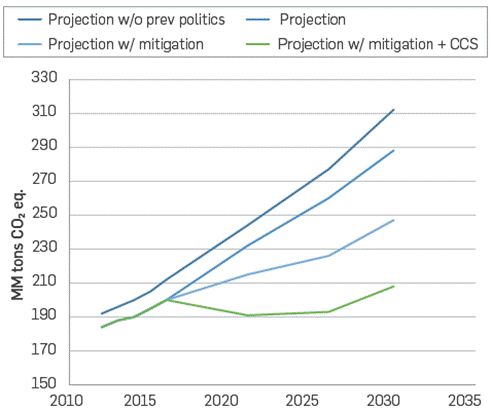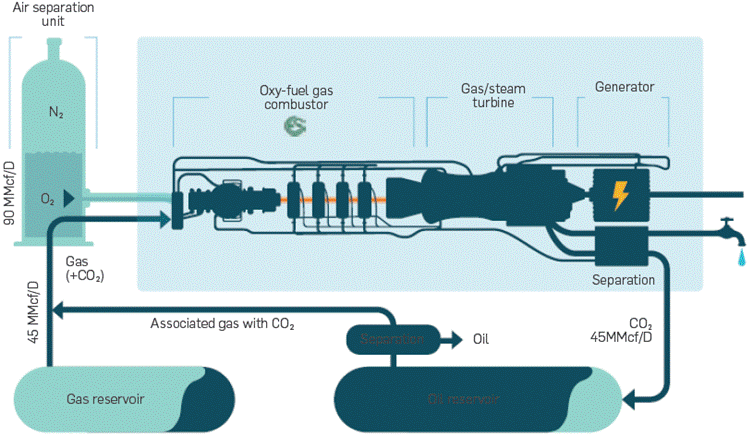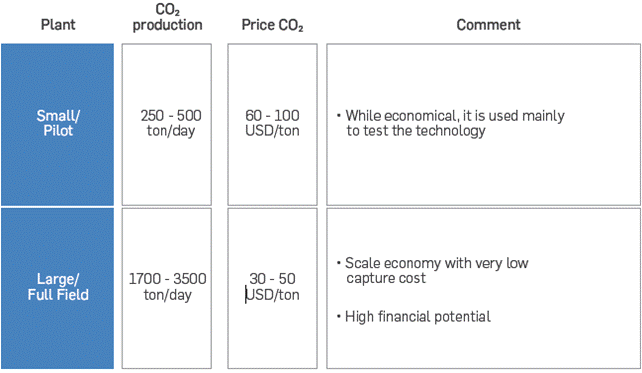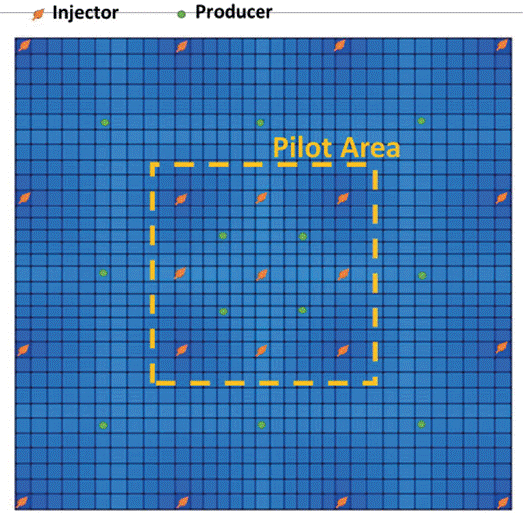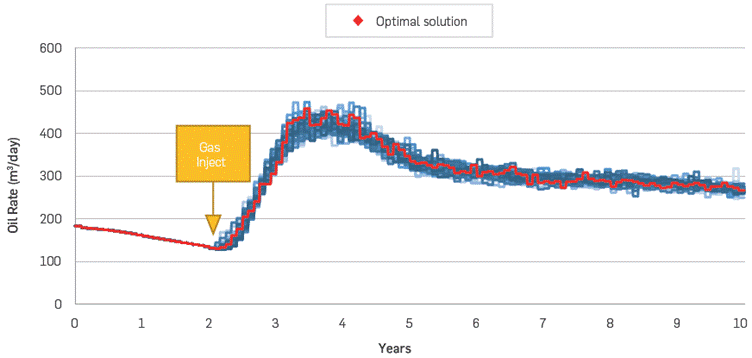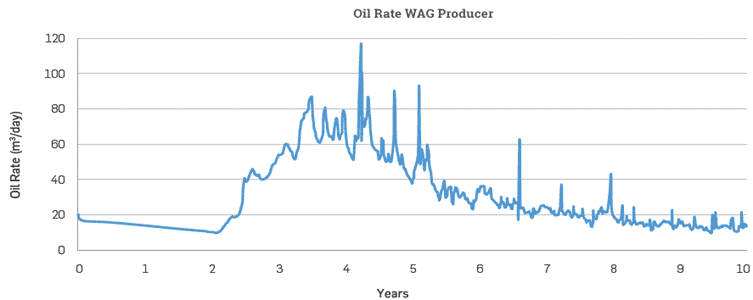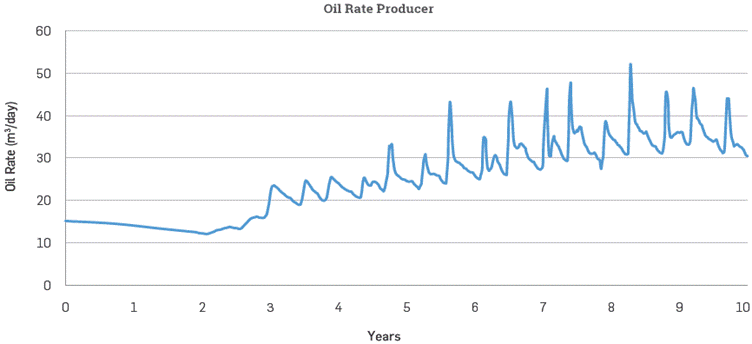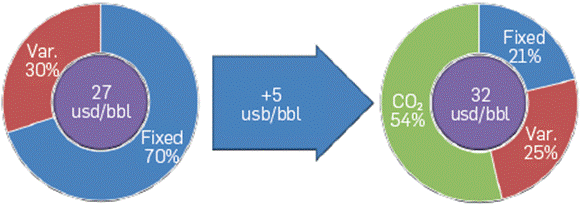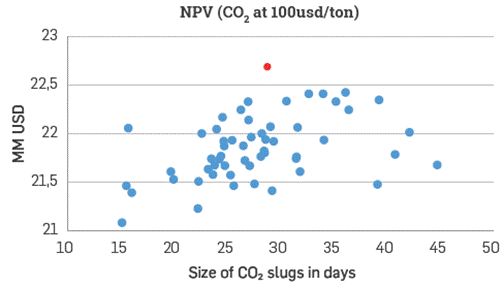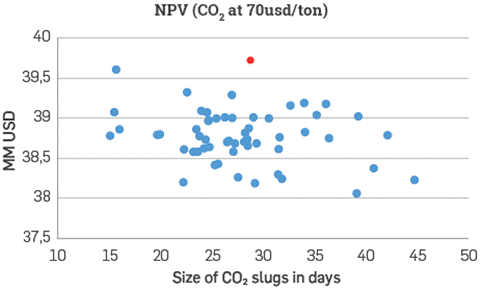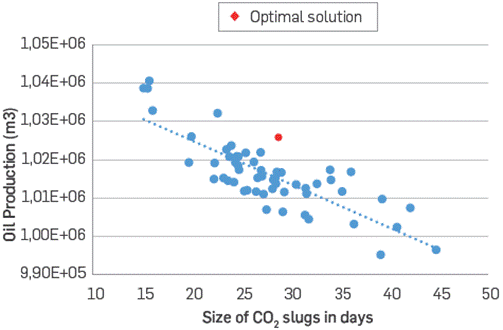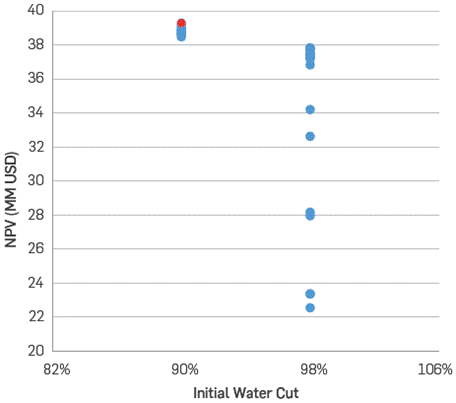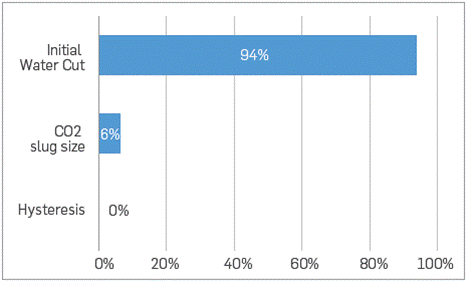1. INTRODUCTION
The oil industry is in a challenging scenario, where local production must be stimulated amid a paradigm shift within the political and social frameworks, which seeks increasingly sustainable energies. In this context and having enormous potential for carbon dioxide capture and sequestration (CCS), tertiary recovery with CO2 has the ability to significantly increase the production of mature fields and reduce greenhouse gas emissions on a large scale. Indeed, CCS projects in Argentina have greater mitigation capacity than all other measures and alternative energy sources combined (Figure In the current situation, where most countries are struggling to meet carbon emission deadlines, CCUS (Carbon Capture Utilization and Storage) appears as a cost-effective mitigation technique. Geological CCUS in Latin America is almost exclusively done through CO2 EOR, being the offshore Lula Field project the first large scale Carbon Capture Utilization and Storage development in the area.
Carbon utilization in a CO2 EOR project has massive storage capacity due to the vast pore volume available in mature reservoirs. While extracting oil, CO2 EOR projects use between 2-3 metric tons of gas per barrel of oil produced. Therefore, CO2 EOR projects could reduce carbon emissions of a produced barrel by up to 50% (depending on the CO2 source and gas utilization)[2], which could account for more than double the emission reduction of other green technologies such as biofuels or electric cars (which usually range about 20% emission reduction)[3,4]. Emission analysis should also take into account that additional oil would otherwise be produces either by other improved/enhanced oil recovery methods. Another way of looking at it, is that a single full field project with a capture rate of 3700-3800 tons/day can store the same amount of CO2 emissions in 10 years than all the mitigated CO2 from the totality of Argentine biodiesel exports from 2008 to 2018 [5].
In recent years, efforts to carry out tertiary recovery projects in the country focused mainly on chemical EOR such as polymers, SP (polymer-surfactant) and ASP (alkalisurfactant-polymer). In Argentina there are few EOR projects with CO2 in the literature, and they are mainly immiscible CO2 gas with high levels of methane (impurities). Only one pilot was made in YPF in 2005 in Chihuido de la Sierra Negra, which was successful in terms of incremental production but unfortunately discontinued.
The injection of miscible or immiscible gas is usually the first option of tertiary recovery in reservoirs of low permeability given the limitations presented by the chemical EOR in these cases[6].
The most significant problems of chemical EOR in reservoirs of low permeability is adsorption/retention and the loss of injectivity. Low permeability rocks usually have clays and other cementitious materials that increase the adsorption of chemicals and small pores that favor the mechanical entrapment of long-molecule polymers. The deposition of chemicals in the rock leads to phenomena of face / formation plugging reducing the permeability and injectivity in the reservoir and jeopardizing the economic and technical success of the project. Even without plugging, the increase in polymer viscosity negatively affects the injectivity in the reservoir and has to be carefully analyzed. It should be considered that the use of smaller molecules could mitigate this problem[7]. In the case of surfactants, these may also generate emulsions decreasing injectivity.
Tertiary recovery with CO2 has the following characteristics:
Decrease in oil viscosity due to CO2 dissolution
Oil swelling due to the dissolution of CO2
Reduction of interfacial tensions between gas and oil, therefore reduction of Sor
The reduction of interfacial tensions (IFT) depends mainly on the pressure, temperature and composition of the solvent and oil. In CO2 EOR cases with injection pressure above the minimum miscibility pressure (MMP) the IFTs are reduced significantly (practically null). The decrease in IFT is linearly related to the effect of capillary pressures[8].
Equation 1, Capillary pressure as a function of interfacial tension (IFT) and pore throat radius (PTR)
Using the capillary number as a method of characterizing the behavior of the fluid in the reservoir, it is observed that for reservoirs of low permeability and small pore sizes, the decrease in IFT plays an important role in the EOR process. In these reservoirs with small pores, low permeability and low fluid viscosities, capillary pressures are dominant over viscous forces.
Equation 2, Capillary number as a function of viscosity fluid velocity (μ) and capillary pressure (σ)
For these reasons, tertiary recovery with CO2 are recommended in these reservoirs compared to other EOR methods. It is also recommended to minimize IFT by injecting high purity CO2 (greater than 90%) at pressures above the MMP to ensure miscibility in most of the reservoir.
CO2 can be used in the case where the use of polymers and surfactants is challenging such as temperatures above 80°C or salinity exceeding 100,000 ppm. It also applies in cases, such as the example of this paper, where current recovery by waterflooding is high and significant amount of the hydrocarbon is trapped as residual oil. There are even successful cases in reservoirs with active aquifers and high recovery factors, where the remaining mobile oil is scarce, and CO2 is injected into the areas of residual oil (ROZ) reducing the Sor and recovering the trapped oil[9].
The most prominent case in Argentina was Chihuido of the Sierra Negra (ChSN), where the pilot stage instance was reached. The ChSN pilot consisted of injecting 65% mol CO2 production gas with the possibility of expanding the project with Puesto Molina's gas, which has a purity of 90% CO2 [10]. The Avilé and Troncoso Lower formations were tested with a Water Alternating Gas (WAG) scheme demonstrating the potential of these types of projects. However, the pilot was interrupted by an early gas break through, attributed to the gravitational segregation[11].
Additionally, the feasibility of a CO2 immiscible WAG with 85% purity gas in Puesto Hernández with encouraging technical and economic results at the laboratory and simulation level[12].
The main limitation for the implementation of CO2 at the local level is the lack of high purity sources. Unlike the United States, the country with the largest number of EOR CO2 projects, Argentina does not have high purity CO2 sources. The USA has a +40 years history of CO2 EOR projects and currently has over a hundred projects underway with a tertiary production. Argentina, on the other hand, has deposits in the northern part of the Neuquén Basin that produce gas with 50% of carbon dioxide or higher. Since CH4 has a significantly greater miscibility pressure than CO2, at the reservoir pressure these production gases are not miscible with oil. This means that the microscopic recovery is lower (less reduction of residual oil, Sor) and that the areal efficiency is also lower given the existence of a gas phase (low viscosity) separated from the oil phase (which when mixed generates a phase with intermediate viscosity). Vertical efficiency also benefits from the use of pure CO2 since its density in a supercritical state is similar to that of oil, unlike methane that has a significantly lower density.
2. STATE OF THE TECHNIQUE
In the last decade, several CO2 capture technologies have been developed and perfected worldwide. The growing interest in mitigating greenhouse gases pushed the research and development of various methods of generating high purity CO2. In addition to the methods of amines and membranes currently used in the country, there are novel capture methods where Oxycombustion, Fuelcells and Air Capture stand out.
The capture of CO2 from the air is through a process of high temperature aqueous solutions (HT DAC) OR low temperature solid sorbent (LT DAC) systems[13]. This is an industrially proven method with success in the food industry (4000 Ton/year). Their capture cost is above 100 USD/Ton of CO2 although costs are being reduced and they usually have access to bonuses or tax deductions that cut up to 35 USD/Ton of the total capture cost. The biggest limitation of this technology is that it is not tested at sufficient flow levels to supply a full field (1-10 MM Ton/year). However, it can be a good complement to other capture mechanisms given its reasonable cost and good perception as a mitigation method. The combination of flue gas and air capture is likely to increase productivity and lower the capture costs.
The carbonate fuelcells generate electrical energy through the use of methane/hydrogen and oxygen/combustion gases. The technology can be combined with internal combustion engines already existing in the fields. This is a technology that promises to capture CO2 at low cost and is being investigated by Exxon. The main limitation would be the ability to produce enough CO2 for a full field project[14]. Carbonate fuelcells may operate as CO2 separators and concentrators while generating electric power at a low capture cost[15],[16].
Oxycombustion technology (Figure 2)[17] is very promising for the Argentine market due to Argentina's low BTU gas sources. This consists of the combustion of hydrocarbon gases with high purity oxygen and generating clean electricity, CO2, N2, low-sal water and heat. By not having N2 as a contaminant, flue gas has high purity of CO2 and NOx emissions are reduced. Due to the lack of nitrogen in the process, CO2 must be recirculated in order to control the temperature of the combustion. By sourcing low BTU gas (with high CO2 content) this process is reduced, and CO2 output is higher Therefore, this process not only admits, but benefits from gases with a high level of CO2 (CO2 concentrations of 50-90%). Gases with high concentrations of carbon dioxide (low BTU) such as those found in some argentine fields in the north of the Neuquen Basin, increase the production of CO2 and lower the capture costs. In this way, CO2 capture costs can be as low as 40 USD/Ton and a full field project can be achieved if sufficient low BTU gas is available. This is a proven large-scale capture technology and its implementation is being studied for EOR pilots (including Mexico[18] and Argentina). Additionally, this process generates N2, fresh water and heat that could be used in projects such as coil tubing, gas cap pressurization, N2 foam EOR, energized fractures, thermal (steam) EOR and low-sal IOR. The process can be optimized for each field increasing the production of the most desired outputs. Oxyfuel combustion seems like the most promising capture technology for the area due to the low capture cost, high CO2 output and versatility.
In the case of this article, we assume that CO2 capture and pressurization costs are between 60-100 USD/ton which are the estimated prices for a pilot scale project in Latin-American conditions. The cost of CO2 is estimated to be significantly lower in the case of a full field plant, higher clean energy selling price (e.g. 100 USD/MWh), heat, N2 and/ or freshwater utilization. Cost estimations for different scales of plants are shown in Figure 3.
CO2/GAS EOR projects are not limited to conventional reservoirs but have also shown technical and economic success in unconventional reservoirs in the United States. CO2 has been extensively studied and there is a documented Occidental pilot in the Permian Basin[19]. Non the less, most GAS EOR pilots (EOG) used hydrocarbon gases, mainly due to accessibility. The possibility obtaining economic on-site generated CO2, can generate a change in the way we operate all types of fields.
3. EXPERIMENTAL DEVELOPMENT
SIMULATION MODEL
The simulation is based on compositional model based on the mmiscible EOR paper which studied the gas injection in the Avile formation in Puesto Hernandez field[7]. Our model consists in a five-spot injection scheme with an injector-producer well spacing of approximately 350 meters. In the pilot area in-fill wells are drilled in the center of the field, decreasing the distance to approximately 180 meters (Figure 4). The dykstra parson is 0.65 with an average permeability of 100 mD. The oil is of an API gravity of 37 degrees with a pressure of multiple contact miscibility (MMP with pure CO2) of 110 bar. The MMP was matched with an analogue sample laboratory slim tube test. While the Puesto Hernandez paper showed a higher MMP, laboratory slim tube testing in the region has shown much lower miscibility pressures. A compositional peng Robinson equation of state model was built in WinProp using the Puesto Hernandez paper EOS parameters. The oil composition was tailored to match the API and the MMP of the oil. A water-flooding model was run until production reached 98% water cut and then-fill wells were placed in the pilot's central area. Water injectors bottom hole pressure was set at 180 bar taking into account typical pump pressure and hydrostatic pressure of 1200 meter deep wells, Wells converted into CO2 injectors had their BHP increased to 220 oar. This pressure was more than sufficient to achieve miscibility ir the CO2 injection area as injection pressure is well above MMP, well distancing was decreased, and reservoir fluid viscosity reduced due to CO2. We found that while some reservoirs have average pressure below MMP, the effect of CO2 on fluid viscosity and infill well drilling can attain the needed conditions for miscibility. The most critical parameters are injector wells BHP and formation fracture pressure, as if CO2 injection pressure can be reasonably above MMP, miscibility can be achieved.
The fully-compositional GEM model simulates a water injection in all the injection wells and then an alternate water and gas injection (WAG) in the wells in the central zone (4 direct five-spots). The CO2 injection limit is of 500 tons/day for the whole pilot which is assumed to be the production limit of a small oxycombustion plant. This lead to the intermittent injection of gas in different wells where 2 wells are always injecting CO2 simultaneously each moment and switch to water injection when CO2 injection is translated to other two wells. This WAG injection scheme is originally repeated about 20 times until finished with a slug of water. In order to control and optimize injection, WAG scheme was controlled through dates where CO2 injection per well lasted 20 days with a proceeding 60/80 days of water injection. Afterwards the injection time was studied using CMOST but maintaining the injection ratios. CO2 slug injection time varied from 15 to 45 days. Relative permeability hysteresis and early CO2 injection (when water cut is 90% instead of 98%) where tested. We continue to make an optimization study in CMOST of the net present value (NPV) of the project to determine the optimal schemes.
ECONOMIC MODEL
The economic model is based on a group of assumptions based on the economic conditions at the time being and cost assessment done by industry experts.
Regarding oil, we used a barrel price of 57 USD/bbl and a lifting cost of 27 USD/bbl made of 70% fixed cost and 30% variable cost. These costs are based on a report from the Ministry of Economy and assessment by industry experts. Additionally, state taxes of 15% were added which includes national taxes and royalties. The only costs that were not considered were depreciations. This is considered a pessimistic scenario since several costs savings were not taken into account. In the case of WAG projects, water cuts decrease and pumps from producing wells are recommended to be removed (replacement by gas lift or natural upwelling), reducing operational and pulling costs. On the other hand, there are incremental costs of anti-corrosive additives and adaptation of the facilities. As a comparison, it can be seen that the company Denbury Resources, who are exclusively dedicated to CO2 EOR, has a lifting cost under 22 usd/boe, which account for a total cost of about 28 usd/ boe taking taxes, marketing and transport costs into account[20]. Denbury Recourses use a mixture of both anthropogenic and natural CO2 sources, although industrial CO2 make up about 30% of their matrix. This allows us to infer that the values of the production costs (excluding the costs of gas and water) should be below the values stated in the paper.
Another significant item is the possibility of a reduction in royalties of up to 50% set by the Argentine law for EOR projects. At the present time, this scheme has been proposed by the province of Mendoza (as it is negotiated with each province). A decrease in royalties would have a high impact on the economic performance of these projects and would allow using greater volumes of CO2 at higher capture costs.
For the cost of CO2, three studies were carried out at a cost of 70 and 100 USD / ton. The cost of water injection was considered to be 0.45 usd / m3. CO2-rich production gas was considered to be sent to the Oxycombustion plant with no additional value added (as if it were vented). In a full field project, if CO2 content is sufficient to achieve miscible displacement, the gas can be re-circulated or treated with membranes lowering the overall cost.
The discount rate for the VAN evaluation is 18% per year. The cost of 8 new in-fill wells is considered in the order of 1.5 MMusd each, totaling of 12 MMusd of CAPEX. All wells were created simultaneously in the model as perforation time is not considered influential compared to the time scope of the model.
4. RESULTS
All cases within the sensitivity analysis showed a significant increment in oil production (Figure 5). The overall field production doubled or tripled, and the effect was maintained through the years. This is mainly due to the decreasing contacted mobile oil available to waterflooding and the large volume of residual oil that could be dissolved in CO2.
Within the pilot area the effect was more pronounced. The producer wells showed 5 to 6 fold increase in oil production (Figure 6). The response was under 6 months due to the drilling of infill wells and reduced acreage. With this methodology we observe good response due to the better volumetric efficiency and the reduced distance between wells. Reducing well spacing is not only a good EOR practice, but it also has a positive impact on economics due to the faster response. Within the pilot area, production peak was reached within under 2 years. While the oil was recovered rapidly in the central area, oil production in farther wells was enhanced in a slower manner (Figure 7). These wells had a slower response but accounted for the maintenance of oil production in time.
RESULTS ANALYSIS
The most influential parameter of the economic model was the cost of CO2 followed by tax deduction. These projects can also be very sensible to oil price, especially when using expensive sources of CO2 and having marginal gains. In the 70 USD/Ton model, the lifting cost per barrel only increased 18% (additional 5USD/bbl) reaching an overall 32 USD/bbl lifting cost (Figure 8). This is not a significant cost increment if oil production growth is taken into account, and it is aligned with the lifting cost increments one could expect from a mature field over a 10 year period. Since the CO2 price represents more than 50% of the production costs, assuring low cost gas is crucial to project viability. Lowering CO2 cost from 100 to 70 USD/ Ton can almost double the profit (Figures 9 and 10). In this model CO2 is assumed to be always purchased and not recycled (which would further lower the project costs), therefore the lifting cost might be lower in practice. Also, further reservoir characterization and injection optimization can lead to further savings.
Time value of money is a critical parameter in developing countries, where discount rates are high. Discount rate in this model is of 18%, but they can be as high as 30% in the region. This is one of the most significant differences between project evaluations in Latin America compared to developed countries. One of the key findings is that higher overall oil recovery is not as significant as the speed in which oil is recovered. Smaller CO2 slugs lead to higher volumetric efficiency (higher ultimate oil recovery), lower gas oil ratios in production and help lower the risk of early breakthrough problems. Nonetheless, larger slugs increase the average mobility of the reservoir fluid and accelerate production response. It can be seen that the optimal NPV result does not correspond to the higher recovery factor scenarios (Figure 11). This is due to the weight of the discount rates and the need for slug optimization regarding, not only oil recovery, but fast recovery. Another key factor for developing countries is the need for fast payout time. With economies with high uncertainty, having a payback time under 4-6 years is vital to ensure project viability. Fortunately, CO2 EOR decreases oil viscosity and reduces water saturation increasing overall oil-phase mobility. This Leads to a fast response time fast payback time. While CO2 EOR projects have higher capital expenditures than other EOR methods, the velocity and magnitude of their response could make them more financially attractive for developing countries. Polymer flooding is the most popular EOR method in the area but has response times in the order of years. Gas injection not only has significantly higher oil recoveries, but also has a response time in the order of months.
One of the key technical variables which affect the profitability of the project, is the volume of oil in the reservoir. While project optimization is important, starting EOR early has a very significant effect over the oil recovery. If the project had started with a scenario of 90% water cut (which is no longer the case), the recovery and economic results would result significantly better than in the 98% water cut case (Figure 12 and 13). In the case of mobile oil, higher oil saturation also account for better economic results. While starting a CO2 EOR project with high water cut is still economically viable, it is strongly advised to start as soon as possible to ensure higher oil saturation in the reservoir. Hysteresis effect was also studied in this paper, and although it is a crucial phenomena in CO2 EOR, it did not have such a significant effect at this point of the study where more significant variables where at stake (Figure 12 and 13). It is clear that starting at a "case" where the field is not as mature and has higher oil saturation and lower water cut is most beneficial.
CONCLUSIONS
All cases show a promising economic performance of CO2 EOR projects, even in unfavorable conditions.
The profit margins seen in the model are higher than any additional expense that could be considered, such as a gas treatment facilities and additional costs related to corrosion.
It is recommended that in order to carry out these projects, efforts be made to achieve moderate CO2 prices and to negotiate royalty discounts to preserve the economic viability of the projects in various scenarios.
When tertiary recovery projects are started early, the economic benefits are significantly better. When sensitivity was made with reservoirs that have higher oil saturation (higher oil saturation and/or higher mobile oil), a significant increase in production and a greater economic return are noted.
CO2 production response is much faster than other EOR and waterflooding projects having production increases within 6 months/ one year. In Latin-American conditions, response time is crucial and projects must return earnings as fast as possible. CO2 EOR could be economically more beneficial (in comparison) in emerging countries due to their high discount rates and low payout times.
Gas injection schemes (e.g. WAG ratio and CO2 slug size) optimization has significant impact on both production (gas oil ratio, ultimate oil recovery) and economics (how fast is oil recovered)
Oxycombustion can provide low cost CO2 at EOR conditions and lower facilities cost. With this technology, CO2 EOR can be possible without pure CO2 source, while low BTU gases reduces capture costs.













